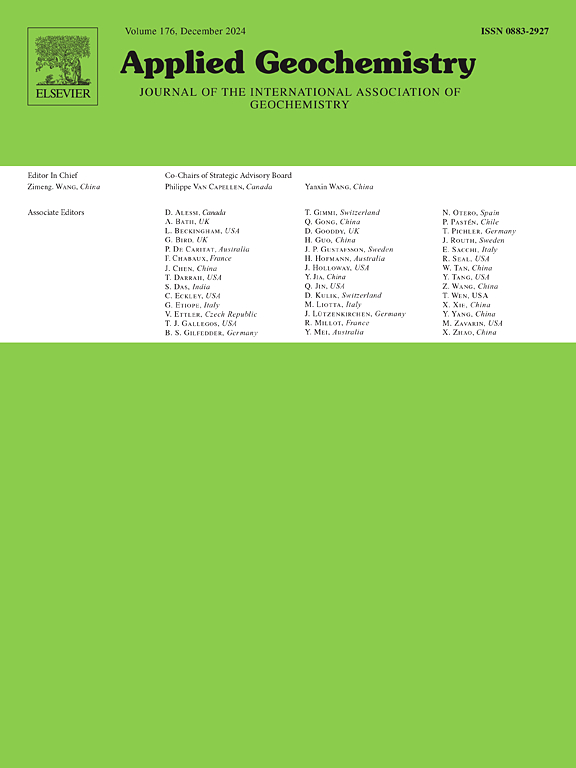黄河下游鲁北平原典型河流平原和沿岸平原浅层地下水砷碘共富集机制
IF 3.4
3区 地球科学
Q1 GEOCHEMISTRY & GEOPHYSICS
引用次数: 0
摘要
浅层高砷(As)和高碘(I)地下水已被广泛研究,但不同环境下的共富集尚不清楚。针对这些问题,研究了鲁北平原典型河流平原(FP)和滨海平原(LP)地下水的水化学特征,阐明了其来源划分,进一步揭示了其对砷、砷富集的控制机制。结果表明,FP区地下水以HCO3-Mg·Ca为主,LP区地下水以Cl-Na为主。FP的水化学以硅酸盐风化(35.6%)、蒸发岩溶蚀(26.9%)和还原性溶蚀(20.1%)为主,LP的水化学以蒸发-海水侵入(32.8%)和硅酸盐风化(29.3%)为主,其次是Mn(22.5%)和Fe矿物的还原性溶蚀(15.4%)。Fe(III)的还原溶蚀和硅酸盐风化作用是As和I共富集的主要过程。其中,地下水As的释放受LP中Fe(III)的还原性溶解和HCO3−的竞争性吸附控制,FP中Fe(III)的还原性溶解和硅酸盐风化作用的促进。地下水ⅰ的富集主要受LP中硅酸盐风化和海水侵入的驱动,而FP中Fe-Mn矿物的还原性溶解和硅酸盐风化则促进了地下水ⅰ的富集。风险评价结果显示,地下水As的风险高于I,尤其是LP(23.3%)和FP(35.5%)的儿童。本工作丰富了As与I的共富集机制,为鲁北平原地下水的安全利用提供了依据。本文章由计算机程序翻译,如有差异,请以英文原文为准。

Mechanisms of arsenic and iodine co-enrichment in shallow groundwater from typical fluvial plain and littoral plain of the Lubei plain in the lower Yellow River, China
High arsenic (As) and iodine (I) groundwater in shallow aquifers have been extensively investigated, but the co-enrichment under different environments is not well-understood. To address these issues, we explored the hydrochemistry of groundwater in typical fluvial plain (FP) and littoral plain (LP) of the Lubei Plain, and elucidated the source apportionment, further revealed its control mechanism on As and I enrichment. Results showed that the groundwaters in FP were mainly HCO3–Mg·Ca and in LP were mainly Cl–Na. Silicate weathering (35.6 %), evaporite dissolution (26.9 %), and reductive dissolution (20.1 %) dominated hydrochemistry in FP, but in LP were evaporation-seawater intrusion (32.8 %) and silicate weathering (29.3 %), followed by reductive dissolution of Mn (22.5 %) and the Fe minerals (15.4 %). Furthermore, the reductive dissolution of Fe(III) and silicate weathering were the dominat processes for As and I co-enrichment. Specifically, groundwater As release were controlled by the reductive dissolution of Fe(III) and the competitive adsorption of HCO3− in LP, while promoted by the reductive dissolution of Fe(III) and silicate weathering in FP. Groundwater I enrichment were driven by silicate weathering and seawater intrusion in LP, but facilitated by reductive dissolution of Fe–Mn minerals and silicate weathering in FP. Risk assessment results showed a higher risk of groundwater As than I, especially for children both in LP (23.3 %) and FP (35.5 %). This work has enriched the co-enrichment mechanism of As and I, providing a basis for the safe utilization of groundwater in the Lubei Plain.
求助全文
通过发布文献求助,成功后即可免费获取论文全文。
去求助
来源期刊

Applied Geochemistry
地学-地球化学与地球物理
CiteScore
6.10
自引率
8.80%
发文量
272
审稿时长
65 days
期刊介绍:
Applied Geochemistry is an international journal devoted to publication of original research papers, rapid research communications and selected review papers in geochemistry and urban geochemistry which have some practical application to an aspect of human endeavour, such as the preservation of the environment, health, waste disposal and the search for resources. Papers on applications of inorganic, organic and isotope geochemistry and geochemical processes are therefore welcome provided they meet the main criterion. Spatial and temporal monitoring case studies are only of interest to our international readership if they present new ideas of broad application.
Topics covered include: (1) Environmental geochemistry (including natural and anthropogenic aspects, and protection and remediation strategies); (2) Hydrogeochemistry (surface and groundwater); (3) Medical (urban) geochemistry; (4) The search for energy resources (in particular unconventional oil and gas or emerging metal resources); (5) Energy exploitation (in particular geothermal energy and CCS); (6) Upgrading of energy and mineral resources where there is a direct geochemical application; and (7) Waste disposal, including nuclear waste disposal.
 求助内容:
求助内容: 应助结果提醒方式:
应助结果提醒方式:


